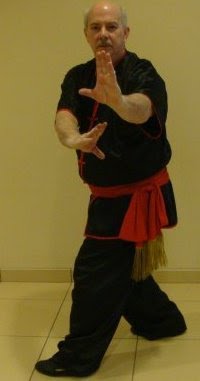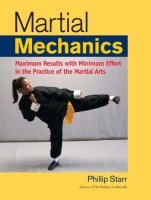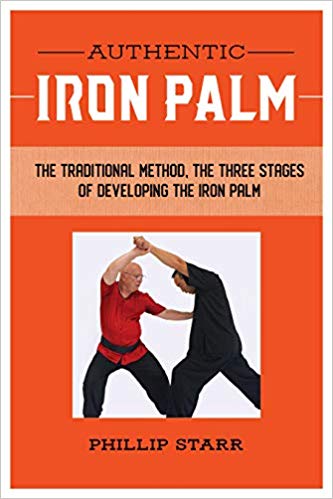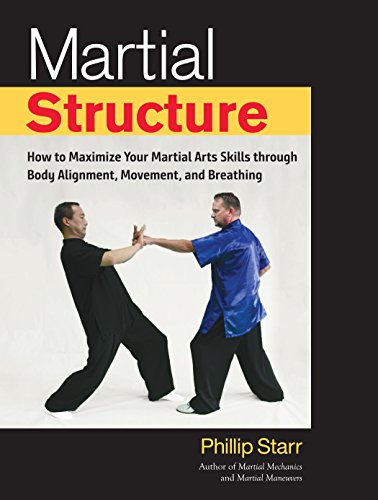In the practice of contemporary martial arts there is a tendency for instructors and students to shy away from any training routine that involves the possibility of much discomfort or injury. This is only natural; as human beings we usually don't usually flock to engage in activities that are inherently painful or risky and we tend to take a hard look at those "weirdos" who do.
I recall watching a group of students practice one-step fighting in a particular martial arts school some years ago. The attacker would step back into the usual pre-attack position, executing a snappy low block as he did so. When the receiver was ready to perform his defensive maneuver he would utter a strong chi-he (kiai, shout) and the attacker would execute a powerful lunging thrust. The receiver would step back, block the attack, and deliver a crisp counter-attack.
Sound familiar? Sure, it does. It's the usual one-step fighting drill. Except for one thing...
The participants were standing at least eight feet apart. When the receiver executed his blocking technique he never touched the aggressor's arm! And when he counter-punched his fist was at least four feet away from the attacker's body!
Naturally, I asked the instructor why the students didn't touch each other at all during this common training exercise. He told me that he didn't want them to bruise their arms or risk striking each other if their blows weren't adequately controlled.
Good Lord.
Well, these folks will be in great shape if they're ever attacked by a strong gust of wind.
Now, don't get me wrong. I certainly don't advocate uncontrolled violence as a training tool. I remember visiting another martial arts school whose members engaged in full-contact sparring within two weeks of enrollment! The neophytes, who had no real knowledge of martial arts technique, were thrown to the lions (the more experienced students) like so much raw meat. To say they got the stuffing pounded out of them would be a serious understatement. The instructor reasoned that if one wanted to become skilled at fighting one had to know what it is like to get hit. Students were told that they had to learn to keep going even if they'd been struck very forcefully because this is what "real combat is like."
Good thing they didn't teach swordsmanship.
Certainly, I believe that students need to develop strong technique and a strong spirit through rigorous training. The key word in that sentence is rigorous. I believe that real martial arts technique and spirit cannot be understood or developed except through the application of controlled violence.
Beginning students are unable to understand this concept and it has to be presented to them very gradually. But as they grow and develop their skills, they must learn to accept this fact and train accordingly. Violence is, after all, why the martial arts were originally developed. They were not cultivated to help their followers discover their "inner child", as a panacea for various ailments, or for thrilling audiences.
I recently told my students that they would learn much more from pain and discomfort than they ever would from sheltered contentment. In traditional Japanese martial arts there is a term describing this type of practice. It is nangyo (in Chinese, nanhang). It refers to hardship (nan) and a road which is traveled by many people, perhaps a crossroads. This is an accepted part of the traditional martial ways; a necessary ingredient for the development of true skill and understanding. The Chinese usually refer to this particular aspect of training as chi-ku (literally, "eat bitter").
In contrast to the aforementioned karate school wherein participants never touched each other, the former head of the Japan Karate Association, Master Masatoshi Nakayama (dec.), recalled that when he was training under Master Gichin Funakoshi during his college years his arms would be so sore and bruised from blocking his partner's attacks that he could hardly lift them. Another kendo master spoke of being struck so hard on the front of his helmet (men) that it knocked him to his knees and splintered his partner's shinai.
Students of the legendary Morihei Uyeshiba (founder of aikido) recalled how his vise-like grip would leave bruises on their wrists and Americans who trained in judo under the revered Kyuzo Mifune spoke of being thrown so hard that they were rendered unconscious. My own teacher, Master W. C. Chen, remembered seeing exhausted classmates bow, run out of the drill line, and vomit.
Some of these things would be considered a tad excessive by today's standards but it gives you an idea of what traditional training was like "back in the day." It was not done because the instructor was a sadistic brute who wanted to puff out his machismo for all the world to see (although such instructors, if that term can be applied to them, have always existed). The instructor's first and only concern was for the students, to help them develop real skill as opposed to something that only looks good but has no real internal substance.
In time, students develop a strong sense of self-confidence. They don't fear being attacked because that happens every night that they attend class. Some years ago one of my students was forced to defend himself against what I call an "Americanus Vomitus" (otherwise known as a common "puke"). When he told me about it he smiled and said, "I wasn't really afraid of the guy at all. Heck, I get punched at by professionals at least three times a week in the training hall!"
For the teachers of the traditional budo ("martial ways"; in Chinese, wu-dao) it's a delicate balance; how far to push the students and keep the violence inherent within the martial arts under control. Naturally, no competent teacher wants to see a student get hurt but some minor injuries are unavoidable and to be expected. Anyone who's spent much time in the martial arts has had his or her fair share of split lips, strawberries, bruises, and the like. Some have even broken a small bone or two. It happens; it's simply the nature of the beast and a necessary part of the developmental processes of the budo. But it is the responsibility of the instructor and senior students to do their best to ensure that the violence never escalates beyond a certain level.
As a student's skill increases the attacks he faces in the training hall must be more realistic until, at an advanced level, they are real. That is, if he fails to perform his defensive maneuver correctly he may well be knocked on his tail.
At the same time, students must (gradually) learn that a bloody lip isn't the end of the world and it's still possible to continue training even after getting smacked in the ribs. Chi-ku.
Tuesday, February 22, 2011
Monday, February 14, 2011
What Will You Do With One Corner?
I was recently reading about a young man’s first visit to Japan. He had trained in iaijutsu and kenjutsu for several years with a Japanese instructor who had come to the U.S. as a college professor. The young American had traveled to Japan to spend time with his sensei and to immerse himself in the country from which his chosen martial disciplines had originated.
When he arrived in Japan, the young American took some time to take in the sights and he was given the opportunity to visit an iaido dojo in a rather small Japanese town. The dojo was run by a hachidan (8th dan, of which there are only a few) who asked him to perform the first basic kata known as “mae.”
The American felt that he had done an adequate job but the headmaster thought differently. He told his guest to work on one particular movement of the kata – it was a bit rough and needed polish. They exchanged bows and the American prepared to repeat the kata.
He gave it his very best but when he finished it he noticed that the headmaster was on the other side of the dojo, giving instruction to another student. What happened next actually showed what this American was made of; it showed his heart.
He continued to practice the kata (which he had practiced for many years as it’s the very first kata taught to beginning iaido students) until he was soaked with sweat. After more than an hour’s worth of repeating the same fundamental kata, one of the senior students walked up and told him to perform the second kata! The American noticed that the headmaster was standing with his arms folded on the other end of the dojo, watching him.
And so it went for the ten “seitei” katas. The American could barely get undressed and walk back to the house where he was staying. His legs were exhausted and he could barely lift his shoulders. But he was back in training the next day.
Now, I often walk away from my students while they are working on a particular form or technique – just to see what they’ll do. Most of them will continue to practice what they were told. A few will walk over to me to ask what they should do and some (yes, it happens with black belts, too) discontinue practicing as they begin to talk and socialize with their classmates.
Confucius said that if a teacher shows the student one corner, the student should be able to find the other three. If he cannot (or will not), then the teacher should leave him alone because he’s simply a waste of time.
My teacher would sometimes show us a particular technique or an aspect of a technique or form and then see what we did with it. Most of my classmates promptly forgot whatever it was that he’d shown them. They didn’t practice it on their own time and their performance didn’t improve. They were not shown any of the deeper aspects of the art because such things require a great deal of practice at home and he knew they’d never meet that requirement.
A few of the others would “fool around” with what they had been shown; they didn’t put in much time on their own and they’d often ask Sifu Chen if they were doing it right, and so on. Again, they received none of the deeper instruction because there was simply no point in it.
Very, very few actually trained regularly (and vigorously) at home with the material they had been shown. But our teacher was watching…always watching. He’d smile and laugh with us but he was always watching and evaluating. And in the end, very few students qualified (in his mind) to learn the real kung-fu.
Friday, February 4, 2011
Everything You Need To Know...
Some years ago there was book written which was entitled, "Everything I Ever Needed To Know About Life I Learned In Kindergarten." It was a beautiful little book and it held true to its title. The author spoke of learning about things like courtesy and consideration, sharing with others, and my favorite part - milk and cookies followed by a nap.
A few years ago at the First National Yiliquan Seminar, I made a statement which, I think, came as something of a surprise to many participants - but only because they'd never thought about it. I said that the whole core of the system (and probably most martial disciplines) is taught in the period we know as "basic training." As we all took time to think about that statement, we all realized how true it is.
This statement doesn't indicate that we necessarily master the many things we learn as beginners; rather, it means simply that we are told about them, shown how to perform them, and encouraged to practice them every day.
Which most students don't.
Thus, the "mysteries" of the art remain as mysteries because so few martial arts enthusiasts neglect their daily practice and fail to look deeply into the art. But consider what is shown to beginning students of Yiliquan (and those of you who practice another martial form can list the "core" items that are taught to beginners in your respective arts):
* Courtesy
* Basic Techniques (The most basic techniques upon which all other techniques are
built.)
* Basic Body Actions and Body Mechanics (which provide power to the basic
techniques)
* Proper Breathing (provides power to the techniques and enhances overall balance)
* Basic Stances (how to stand in a balanced manner)
* Basic Stepping Methods (footwork - how to move from one stance to another)
* Moving From One-Point
* How To Fall (breakfalls - there's more to this than meets the eye)
* Fundamentals of qigong (4 Principles and basic exercises)
You'll notice that the items listed above are all interrelated; they "dovetail" into each other although a beginner cannot see how this is possible. Senior practitioners will immediately notice the relationships between these items.
It's obviously way too much for anyone to thoroughly learn in a short time. In fact, this material will require years of regular and rigorous practice. And almost everything that is taught to the student after this stage is just frosting; training that promotes a deep understanding of the items on this basic list and fosters the development of real skill.
As students progress through the system and learn more complex material they often lose sight of the basic material they were shown as novices. What they fail to understand is that what they learned as a beginner must be applied to everything they learn from that point on.
They must learn how to apply these things to their forms which become increasingly complex. They have to learn to apply them when they practice formal Three and One Step Fight, Freestyle One-Step, Freestyle Sparring (!!!), Self-Defense, Weapons Forms, and so on.
For instance, take a minute and run through one of your forms. When you've finished go back and see if you used the correct form of breathing. Were you moving from your One-Point? Were your body actions correct? And bear in mind that you must practice each form until it can be executed perfectly without having to check each of these items!
That kind of skill can't be developed overnight. It can't be developed through haphazard practice, either.
Senior martial arts practitioners don't possess any secret knowledge. They don't practice highly advanced, secret techniques. Instead, they simply practice the basics. Every. Day. Everything they really needed to know about their respective martial disciplines they probably learned from their teachers in the earliest stages of training. They've simply learned how to fit everything together.
Our Association's Chief Instructor, Mr. Jeremy Thompson, and I attended an iaido (the art of drawing and cutting with the Japanese sword) tournament and testing in Council Bluffs, Iowa. I was told that it was probably the largest such event in the entire United States that year! Anyway, during the examinations (which were held for all grades up to and including 6th dan) I noticed that ALL EXAMINEES were made to perform the most basic iaido kata known simply as "Mae" (meaning "Forward"). Without going into a lot of detail about the minutae of this particular kata, it begins in a kneeling position. The practitioner comes up to one knee and draws the sword in a horizontal cut with one hand. The sword is then brought back, gripped with both hands, and an overhead cut is executed. The swordsman then rises to his/her feet, performs a blood shake (to shake imaginary blood from the blade) before re-sheathing it.
It sounds simple enough to do and by the time an iaido student reaches the stage of sankyu or so, he or she can perform it with considerable skill. But consider...someone testing for 5th or 6th dan is also required to do it. Such a person has put 25 years or more in training! You'd think they'd have it right by that time, wouldn't you?
Sure. They can do it correctly. But they have to do it MORE correctly than someone of a lower grade. All of the items they learned as beginners have to become an integral part of their movement and technique without conscious effort. IT must become them and THEY must become it.
Moreover, the essence of all other techniques and kata are contained within this first, basic kata. Once this one is truly mastered, so mastery of the others follows easily.
Everything you really need to know about your martial art, you learned in kindergarten...
Subscribe to:
Posts (Atom)














